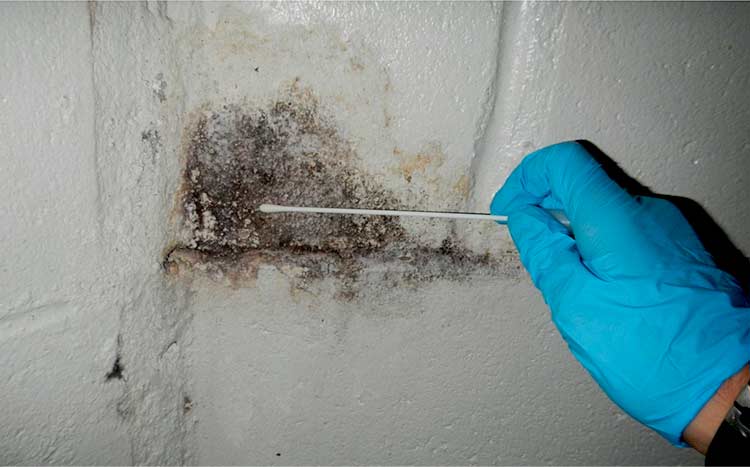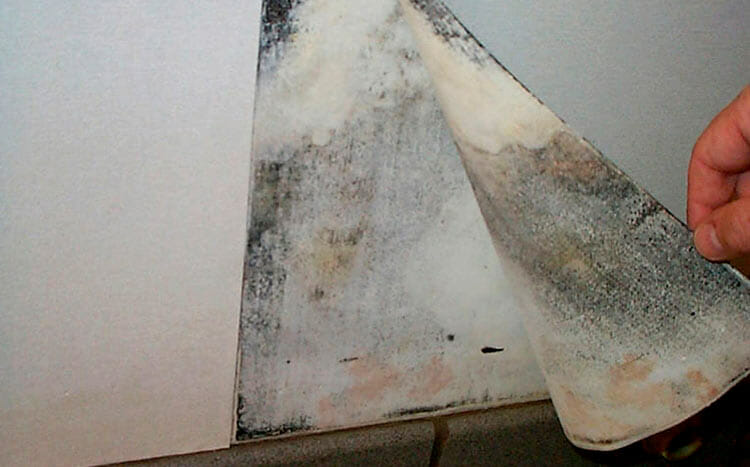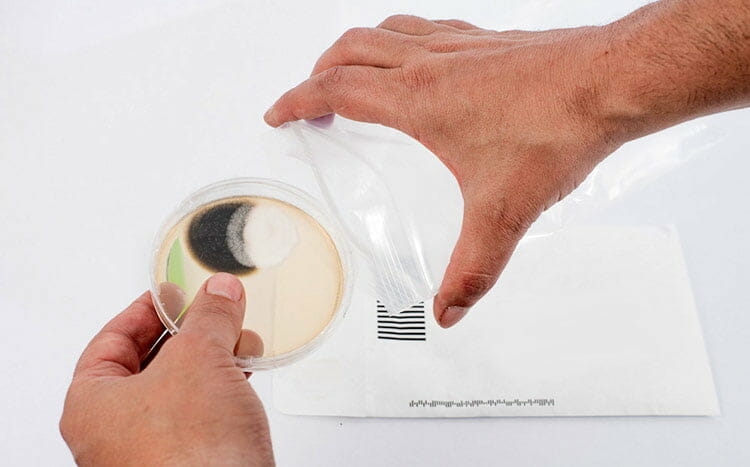Mold usually flourishes in moist, poorly lit areas like basements, as these settings provide perfect conditions for its proliferation. The presence of any kind of mold in your house represents a health risk for you and your family by inhaling it. Keep reading to discover methods to detect and recognize mold in basements, in addition to strategies for dealing with it.
You can test for mold in your basement using an off-the-shelf mold testing kit, the smell test, or through simple visual inspection. You can also have a certified mold inspector conduct more comprehensive scientific tests to be used for remediation planning. Make sure you observe the safety guidelines when testing for mold in your basement to avoid accidental exposure.
The following is a step-by-step guide on what to do with mold in your basement starting from the testing phase:
Step 1: Visual Inspection
Visual inspection is a limited but simple way to find out if you have mold in your basement. If you know what to look for, you can tell where the mold is growing, risk levels, and its possible origins. However, you should take all the necessary precautions when testing like wearing a mask and gloves.
Things to do before the visual inspection:
- Protect yourself from accidental exposure to dangerous levels of mold spores by wearing a face covering and gloves especially if you are asthmatic or have allergies
- Make sure the basement is well-lit so that you can see each corner and crevice.
- Remove or move large items such as old couches and tools that may be hiding mold growth
- Open any windows or doors so that there is proper air circulation
- Use a torch or infrared light if available for more detailed inspection
To do a successful visual inspection you should understand the physical characteristics of mold. This will help you differentiate between mold, dirt, and stains and also know what kind of mold is growing in your basement.
Molds are just normal living organisms that are part of the fungi kingdom. They can grow indoors or outdoors so long as the conditions are favorable.
This is why dark, moist environments in basements, attics, and bathrooms tend to attract molds. There are adequate dead organic materials in there to sustain them.
Mold usually grows on surfaces such as walls and ceilings. Any type of growth with an elongated sponge-like appearance on the surface is probably mold or mildew. Sometimes, the mold could have thread-like strings that break off with the slightest disturbance such as from the disturbed air from an air-conditioning fan. These spores can be toxic and trigger coughing or sneezing for some individuals or household pets and more serious health problems with long-term exposure.
If there are black spots or dark smudges on the walls, ceilings, or furniture in your basement, then you probably have black mold and must order remediation as soon as possible. Mold could also be observed floating around in the air if it’s at dangerously high levels.
Here is a simple step-by-step approach to doing visual inspections for mold in your basements:
- Gear up with your protective equipment- face covering (N95 mask and gloves).
- Make sure the basement is well lit
- Start from the entrance and do a thorough inspection of the walls and other surfaces. Use a bright flashlight for dark corners and crevices.
- Take note of the areas that could potentially have mold.
- Use an infrared light to highlight areas that have excess moisture or water.
- Document your findings and plan how to have the mold cleaned out safely.

Step 2: The Smell Test
Mold can be smelled in the air pretty easily especially if it has spread and released its spores. Most types of mold have a pungent or earthy smell that is not easy to miss. In some cases, inhaling mold spores can trigger sneezing or coughing so tests should be limited to a few seconds and only those without any respiratory conditions such as asthma should attempt them.
If you cannot smell anything in the basement, try turning on the fan or air conditioning unit. This will disturb the air in the room and cause any hidden mold spores to break off and become airborne. Changes in humidity may also lead to an increase in mold spores in the air. If you are certain that you can smell mold spores in the basement, you should plan to have remediation done as soon as possible.
Step 3: Is It Mold or Dirt?
It’s easy to think that you have toxic mold in your basement when in fact it’s only harmless dirt that can be wiped off easily. Mold usually grows in a pattern and leaves the underlying paintwork peeling off if wiped off with a cloth. Since it’s a fungus, touching it or disturbing it in any way will cause the string likes spores to break off and become airborne. Mold is also a type of fungi and will, therefore, spread to other areas or increase in density, unlike dirt.
That said, some mold types and young molds are too tiny or microscopic and appear as dirt to the necked eye. More comprehensive tests done by a qualified mold inspector are recommended to ascertain that it’s mold. You can also do a simple chemical test using an off-the-shelf testing kit as explained in the next step.
Step 4: Using Testing Kit
An off-the-shelf mold testing kit can help you test and detect mold and mildew in your basement. They are available as all-in-one kits complete with a petri dish and microbial culture. However, you need to know which mold testing kit to use and how to use it otherwise you may get negative test results while there is mold in your basement especially at the early stages.
Here is what you need to do if you have purchased a mold testing kit or have access to one:
- Open the mold testing kit as guided on the user manual or label that came with the packaging and access the petri dish.
- Remove the lead and place the open dish in a dark corner of your basement.
- Leave it there for at least a day or two.
- Remove the open petri dish and replace the lid making sure it is closed tight. You can use some clear tape (not masking tape) to seal it. Keep it in a dark area or inside a drawer for a week or two.
Most off- the shelf mold testing kits work on a simple principle, inside the dish are microbial cultures (organic matter) that will provide food for mold or mildew. If there is mold, some of its floating spores will fall into the petri dish. Sealing and keeping the test dish in a dark area will allow the mold spores to feed on the microbial cultures and grow.
Checking the Test Results
After a week or two, remove the lid on the test dish and see if any mold or mildew is growing inside. If there is none, then you probably don’t have mold in your basement. However, you may need to repeat the test once or twice to be certain or find an inspector to be completely certain especially if you can smell mold or if there is dampness or leakages in your basements. Some mold varieties are hard to detect with simple DIY tests but still pose a danger to you.
Some mold testing kit manufacturers also provide a mailing address where you can send the sealed testing kit for further analysis. Using more advanced equipment and chemical testing, they can be able to detect tiny mold particles or advise on the type of mold you could be having and its toxicity or lack thereof.
Step 5: Remediation
If you are sure (through testing) that you have mold in your basement, the next step is to schedule remediation to get rid of the mold or bring it to healthy levels. Do note that trace amounts of mold in the air are normal. It is when it reaches certain levels that it becomes dangerous to you and your loved ones.
Remediation is usually done by certified mold experts who have the proper equipment and can detect and remove mold safely. For this, you need to find a reputable mold removal/remediation service near you that will inspect and do the remediation according to EPA standards. You can use our free service to find top-rated mold experts as explained below:
- Scroll to the top of the page and enter your Zipcode
- Answer questions about what you want to be done
- The information you enter will be forwarded to three local mold experts. They will send you a price estimate for the job and some friendly advice
IMPORTANT: There is no obligation to hire. This is a free tool and service to be used at your pleasure
Testing for Hidden Mold
Sometimes it can be hard or impossible to test for mold especially if it is hidden in hard-to-access areas such as behind drywall or inside a ceiling. To test for hidden mold, you can do an air test to determine the quality of air and detect any floating mold spores.

Step 0: Air Testing
Testing the air for mold spores will tell you fairly quickly if there is hidden mold in the basement you might have missed when conducting a visual and surface test. Air testing involves taking samples of the air in your basement using a suction pump or air sampler. Several devices are used during air samplings such as particle collectors and digital air quality test kits.
Step 1: Mold Behind Walls
You don’t have to tear down drywall to test for invisible mold. Professional inspectors can use a range of devices and methods to test the air quality in your basement and detect floating mold spores.
Step 2: Air Ducts
Mold presence can be detected easily by doing an air test in the ducts. This is one of the areas that professional inspectors prioritize in their tests as the presence of mold spores in the ducts means the entire air circulation in the house/building is affected.
Step 3: Under Carpets or Floors
Another area where you are likely to find hidden mold is under carpets or floors because conditions are perfect for mold to grow and spread due to warmth and the presence of organic matter. You can determine if there is mold in these areas with a chemical swab test or an air test.
Step 4: Toilets
Toilets and bathrooms tend to attract mold and mildew more than any other room because of the excess humidity. In addition to the basement, you should also test these areas for mold and do remediation in one go.
Step 5: Water Leaks
Check for water leaks in your basement, bathrooms, and other areas where you suspect there could be mold. Fixing water leaks will prevent future occurrences after the remediation has been completed. Remediation services often recommend these fixes after they are done removing the mold.
Other Signs You Have Mold in Basement
Here are some of the signs that you may have mold in your basement or any other room in your house:
- A musty, pungent, or earthy smell in the basement
- Dark spots on drywall
- If you sneeze, cough, or feel itchy when you spend time in the basement
- Cracking, warping, or peeling of paint on walls and furniture
- High humidity and unusually low temperatures on the walls and furniture when you touch them
DIY Mold Testing vs. Hiring an Expert
You can opt to do mold testing on your own or have a professional do it for you. Both choices have advantages and disadvantages:
Do it Yourself
Pros
- Cheap- You don’t have to pay an inspector to do the tests
- Flexible timing- you can do the tests on your own time including after hours
Cons
- You may not get conclusive results or have wrong results if you use the wrong testing kits or methods
- You cannot create a mold inspection certificate if you are not a certified mold inspector.
- You may need a certificate to prove that your house or building is mold-free for sale or in court.
Hiring an Expert
Pros
- Experts do thorough inspections and can detect hidden or traces of mold and mildew
- They can advise you on how to remediate or fix the source of molds in your house
- They are certified and able to produce comprehensive reports and inspection certificates admissible in a court of law.
You can always start by doing the basic tests if you suspect that there is mold in your basement before you order for more comprehensive tests and remediation. The most important thing is to be certain that there is no mold growing in your house and posing a danger to you and your loved ones.







